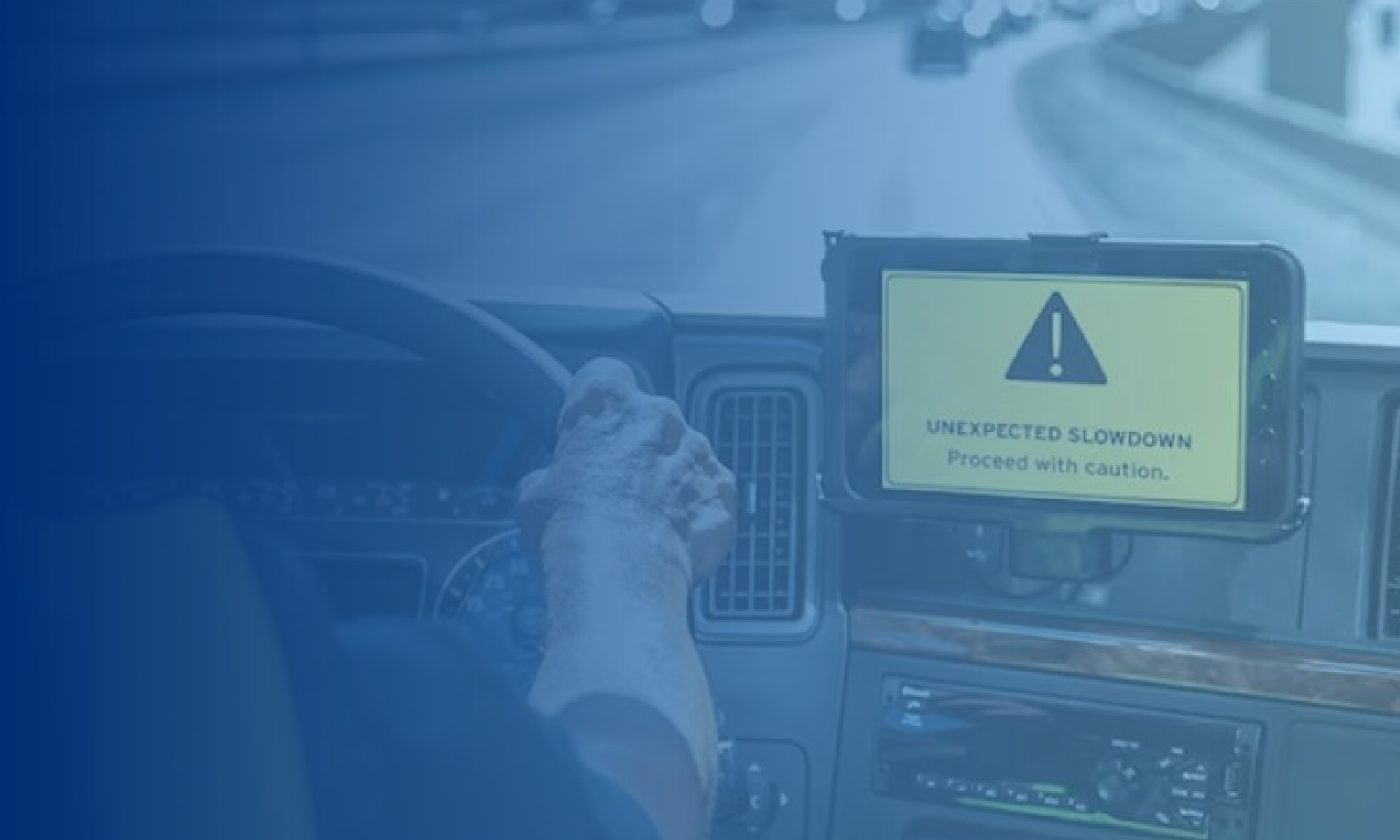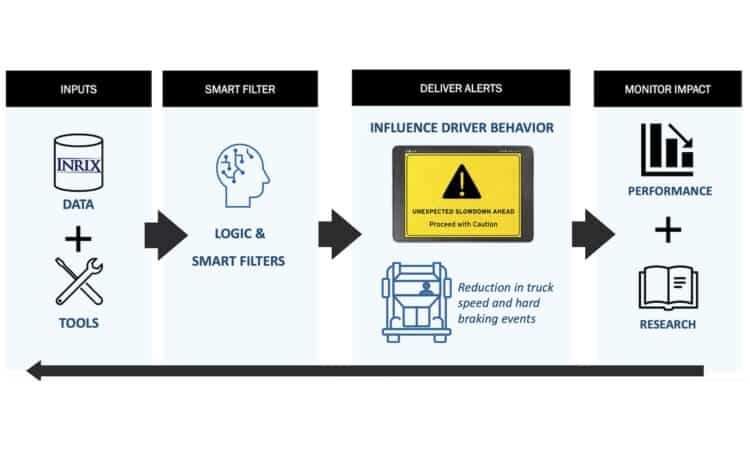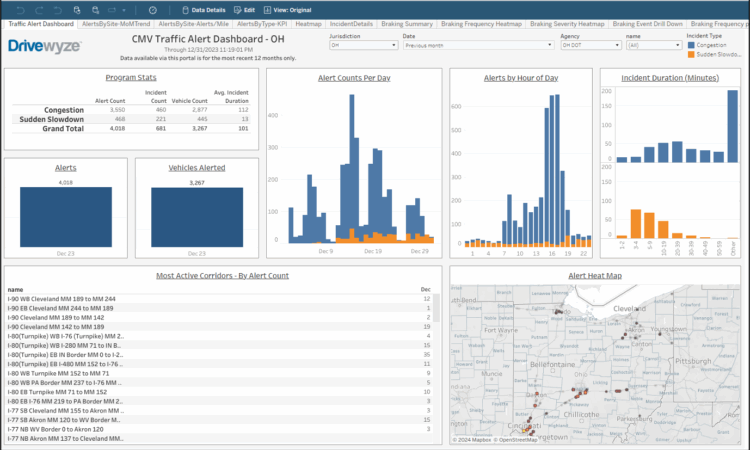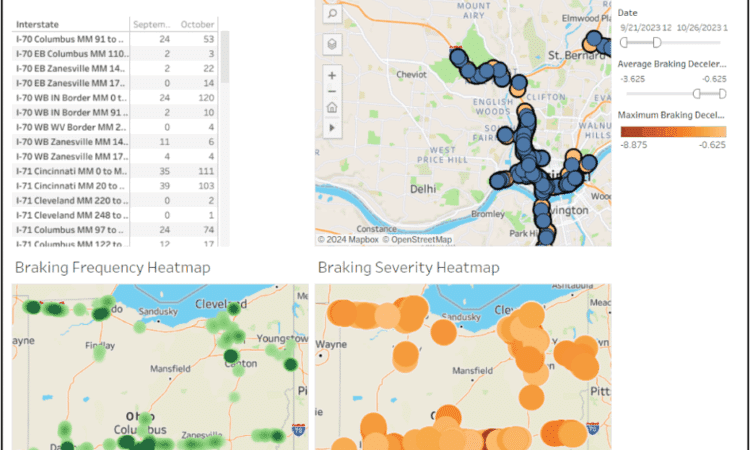
Every day, millions of commercial trucks navigate America’s highways, where a single moment of delayed reaction can mean the difference between a safe arrival and a serious collision. When a truck traveling at highway speeds encounters sudden congestion, physics becomes an unforgiving adversary—these massive vehicles require 66% more stopping distance than passenger cars.
Thankfully, Drivewyze Smart Roadways Alerts—powered by real-time INRIX data—is transforming the way drivers stay safe, delivering proactive safety alerts that give them the critical awareness and time needed to avoid crashes.
The integration of INRIX’s real-time traffic data and alerts with Drivewyze’s extensive connected truck network represents a fundamental shift in commercial vehicle safety. By analyzing over a billion miles of daily vehicle movements across the United States, this system detects dangerous slowdowns and delivers targeted alerts directly to truck cabs—typically 2-3 miles before drivers encounter hazards. This advance warning system has already demonstrated clear effectiveness, with studies showing that 22-26% of alerted drivers reduce their speed by at least 5 mph within 30 seconds of receiving warnings.
How INRIX Detects Dangerous Conditions
At the heart of this life-saving technology lies INRIX’s sophisticated traffic monitoring infrastructure. The system continuously analyzes data from millions of anonymous probes and connected vehicles traveling the road networks, using advanced algorithms to identify and characterize traffic patterns in real-time.
The detection process operates on multiple levels of analysis. First, INRIX’s algorithms establish baseline traffic flow patterns for every segment of monitored roadway, understanding typical speeds and congestion patterns by time of day, day of week, and seasonal variations. When current conditions deviate significantly from these baselines—indicating sudden slowdowns or atypical congestion—the system immediately flags these locations for alert generation.
Key detection capabilities include:
- Minute-by-minute updates on congestion location and severity changes
- Identification of sudden speed drops that indicate dangerous conditions
- Differentiation between typical rush-hour congestion and unexpected congestion
- Real-time tracking of incident progression and clearing
The system’s ability to detect “dangerous slowdowns” versus normal traffic variations is critical. A sudden drop from 70 mph to 20 mph on a typically free-flowing interstate segment triggers immediate alert protocols, while gradual speed reductions in known congestion zones may not warrant driver warnings. This intelligent filtering makes sure that drivers receive only the most relevant and actionable alerts—a critical feature for in-vehicle messages.
From Detection to Driver Action
Once INRIX identifies a hazardous condition, the alert delivery process engages through Drivewyze’s extensive connected truck infrastructure, specifically through Drivewyze’s Smart Roadways system. This integration represents a technical achievement in real-time data distribution at scale.
The alert delivery flow operates as follows:

Step 1: Geo-fencing and Targeting
Drivewyze’s platform employs accurate geo-fencing technology to identify which trucks are approaching the exact hazard location detected by INRIX. The system calculates vehicle trajectories based on current location, speed, and direction to determine which drivers need to receive the alerts.
Step 2: Alert Transmission via ELDs
Alerts are delivered through Electronic Logging Devices (ELDs), which are federally mandated equipment in most commercial trucks. This existing infrastructure provides an always-on communication channel that doesn’t rely on drivers actively using navigation apps or other optional systems. The integration with major ELD providers a broad coverage across the trucking industry.
Step 3: Driver Notification
When a truck enters the alert zone (typically 2-3 miles before the hazard), drivers receive both visual and audible warnings. Messages like “Sudden Slowdown Ahead” or “Congestion Ahead” appear on their ELD screens, accompanied by distinctive audio alert that cut through cab noise. The alerting system provides an initial warning followed by a more urgent “Caution: Dangerous Slowdown Ahead” message as the hazard becomes imminent.
Delivered Through Agencies
State transportation agencies play a key role in system configuration, defining priority routes and setting alert thresholds based on local safety priorities. For example, a mountainous corridor with frequent weather-related slowdowns might have different alert parameters than a relatively flat interstate section where sudden congestion is rare. This customization capability allows the system to address specific regional safety challenges while maintaining consistent operational standards.
The transportation agencies also can monitor analytics on both alert locations and driver behavior impact. This data provides agencies with unprecedented insights into how commercial vehicles navigate their road networks, where safety risks may be concentrated, and how effectively different alert strategies influence driver behavior. Agencies can track metrics such as speed reductions by location, alert response rates, and changes in crash patterns over time.
This partnership model ensures that while the technology operates in a consistent matter at a national scale, implementation remains responsive to local conditions and priorities. Transportation agencies maintain control over their safety programs while benefiting from the extensive reach and technical capabilities of the INRIX-Drivewyze platform.
Early Results: Promising Impact on Driver Behavior
Initial deployments of the INRIX & Drivewyze alert system are showing encouraging results that point to safety improvements and positive changes in driver behavior. A study by Cleveland State University found that secondary crashes involving trucks in Ohio decreased by 29% over a two-year period when drivers were receiving these proactive alerts. Similarly, Purdue University researchers documented that approximately 22% of drivers receiving sudden slowdown alerts reduced their speed by at least 5 mph within 30 seconds—a change in driver behavior that can mean the difference between a near-miss and a collision when multiplied by proper following distance. These early results show that drivers are more attentive to conditions ahead when receiving these alerts.
The system’s effectiveness extends beyond individual driver responses. In Atlanta, pilot testing involving over 500,000 vehicle visits, hard braking incidents decreased by 10-16% (compared to drivers not receiving these alerts), indicating that alerts help drivers adopt smoother, more anticipatory driving patterns.
Looking Ahead: The Future of Proactive Commercial Vehicle Safety
As this technology continues to evolve, the integration of INRIX traffic intelligence with Drivewyze’s connected truck network represents only the beginning of a transformation in commercial vehicle safety. The infrastructure now in place—already reaching hundreds of thousands of trucks—provides a foundation for expanding safety capabilities beyond traffic alerts. This platform is being expanded to reach more trucks (by offering free access to fleets and drivers) as well as the integration of more critical data.
Future enhancements under development include integration with weather data for condition-specific warnings, critical work zone warnings for approaching commercial vehicles, and predictive analytics to anticipate congestion before it occurs. The collection of driver response data, including driver behavior analytics, enables transportation agencies to better understand and address the human factors in commercial vehicle safety.
For transportation agencies seeking to improve safety outcomes while managing costs, this infrastructure-free approach offers compelling advantages over traditional infrastructure-based solutions. Rather than installing expensive dynamic message signs with limited reach, agencies can immediately activate in-vehicle safety programs across entire road networks, delivering targeted information to the vehicles most at risk.
The marriage of INRIX’s traffic data with Drivewyze’s delivery infrastructure demonstrates how existing technologies can be combined innovatively to address longstanding safety challenges. As the system expands and refines its capabilities, the vision of eliminating preventable commercial vehicle crashes moves from aspiration to achievable reality—one alert at a time.
Want to learn more about Drivewyze Smart Roadways Alerts?
Join our upcoming webinar, Traffic Slowdown Alerts: How In-Cab Alerts Are Helping Fleets and Agencies Improve Safety Outcomes, to get a detailed look at this solution.

What You’ll Learn
- How real-time alerts help reduce emergency braking and secondary collisions
- How INRIX data powers instant detection of sudden traffic slowdowns
- Key impact data from state deployments (e.g., Ohio DOT)
- What sets Drivewyze apart in scale, speed, and ease of deployment







